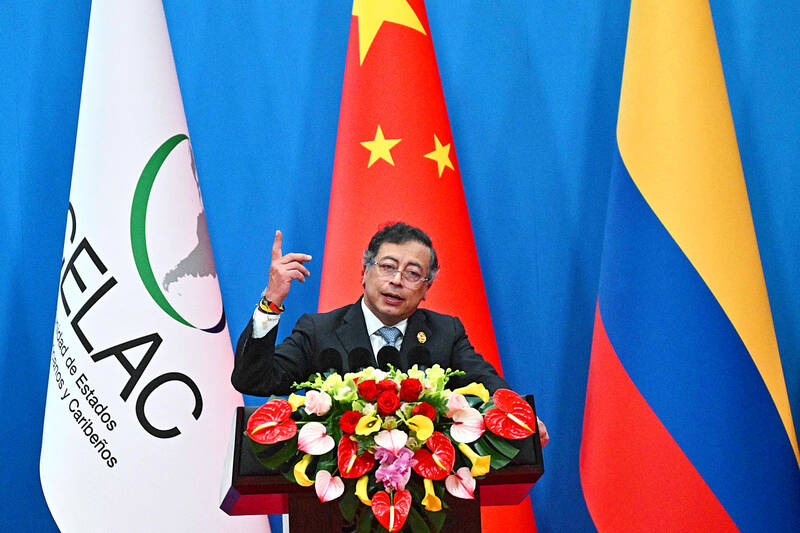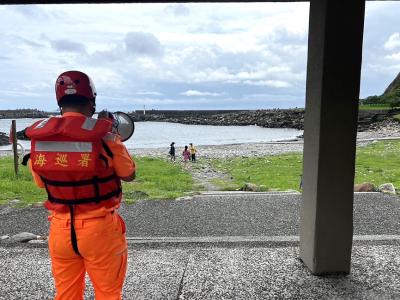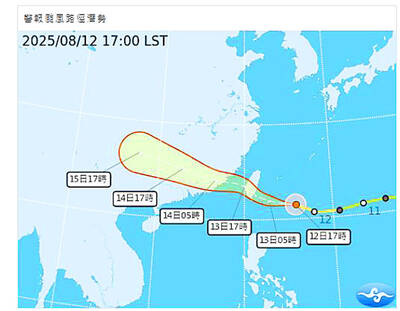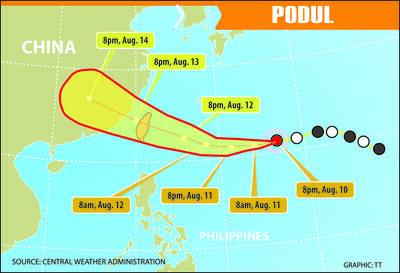Chinese President Xi Jinping (習近平) yesterday vowed to deepen ties with Latin America and condemned “bullying” in a thinly veiled swipe at the US, as he addressed regional leaders in Beijing.
Leaders and officials from Latin America and the Caribbean have descended on the Chinese capital for the China-CELAC (Community of Latin American and Caribbean States) Forum.
Beijing has stepped up economic and political cooperation with Latin American nations and has urged a united front against US President Donald Trump’s maelstrom of tariffs.

Photo: AFP
Latin America has emerged as a key battleground in Trump’s confrontation with China, and the region is coming under pressure from Washington to choose a side.
Addressing leaders yesterday, Xi hailed China’s burgeoning ties with the region.
“Although China lies far from the Latin American and Caribbean region, the two sides have a time-honored history of friendly exchanges,” Xi told the opening ceremony, likening the summit to a “great, sturdy tree.”
“Only through unity and cooperation can countries safeguard global peace and stability, and promote worldwide development and prosperity,” he said.
The Chinese president also pledged US$9.2 billion in credit toward “development” for the region — part of a broad set of initiatives aimed at deepening cooperation, including on infrastructure and clean energy.
Beijing would also work with the region in counterterrorism and fighting transnational organized crime, Xi said, as well as enhancing exchanges such as scholarships and training programs.
Xi’s remarks come a day after the US and China announced a deal to drastically reduce tit-for-tat tariffs for 90 days, an outcome Trump dubbed a “total reset.”
Under that agreement, the US agreed to lower its tariffs on Chinese goods to 30 percent, while China would reduce its own to 10 percent.
The deal marked a major de-escalation of a grueling trade war between the world’s two largest economies, which threw global markets into turmoil.
“There are no winners in tariff wars or trade wars,” Xi said. “Bullying and hegemony will only lead to self-isolation.”
“The world today is undergoing accelerated transformations unseen in a century, with multiple risks intertwined and overlapping,” he said.
Among notable attendees at the forum was Brazilian President Luiz Inacio Lula da Silva, who arrived in Beijing on Saturday for a five-day state visit.
Also present was Colombian President Gustavo Petro, who last week said that he intends to sign an accord to join Beijing’s Belt and Road Initiative during his visit.
Petro called for “dialogue between civilizations” that took into account the interests of the region.
“A horizontal dialogue, rather than a vertical one, can be free of authoritarianism, of imperialism, of the give and take between civilizations,” he said.
Two-thirds of Latin American nations have joined Beijing’s infrastructure program, and China has surpassed the US as the biggest trading partner of Brazil, Peru and Chile, among others.
Chilean President Gabriel Boric told the forum that his nation would take a “leap forward in economic relations with China.”

DEFENSE: The first set of three NASAMS that were previously purchased is expected to be delivered by the end of this year and deployed near the capital, sources said Taiwan plans to procure 28 more sets of M-142 High Mobility Artillery Rocket Systems (HIMARS), as well as nine additional sets of National Advanced Surface-to-Air Missile Systems (NASAMS), military sources said yesterday. Taiwan had previously purchased 29 HIMARS launchers from the US and received the first 11 last year. Once the planned purchases are completed and delivered, Taiwan would have 57 sets of HIMARS. The army has also increased the number of MGM-140 Army Tactical Missile Systems (ATACMS) purchased from 64 to 84, the sources added. Each HIMARS launch pod can carry six Guided Multiple Launch Rocket Systems, capable of

Tropical Storm Podul strengthened into a typhoon at 8pm yesterday, the Central Weather Administration (CWA) said, with a sea warning to be issued late last night or early this morning. As of 8pm, the typhoon was 1,020km east of Oluanpi (鵝鑾鼻), Taiwan’s southernmost tip, moving west at 23kph. The storm carried maximum sustained winds of 119kph and gusts reaching 155kph, the CWA said. Based on the tropical storm’s trajectory, a land warning could be issued any time from midday today, it added. CWA forecaster Chang Chun-yao (張竣堯) said Podul is a fast-moving storm that is forecast to bring its heaviest rainfall and strongest

GET TO SAFETY: Authorities were scrambling to evacuate nearly 700 people in Hualien County to prepare for overflow from a natural dam formed by a previous typhoon Typhoon Podul yesterday intensified and accelerated as it neared Taiwan, with the impact expected to be felt overnight, the Central Weather Administration (CWA) said, while the Directorate-General of Personnel Administration announced that schools and government offices in most areas of southern and eastern Taiwan would be closed today. The affected regions are Tainan, Kaohsiung and Chiayi City, and Yunlin, Chiayi, Pingtung, Hualien and Taitung counties, as well as the outlying Penghu County. As of 10pm last night, the storm was about 370km east-southeast of Taitung County, moving west-northwest at 27kph, CWA data showed. With a radius of 120km, Podul is carrying maximum sustained

TRAJECTORY: The severe tropical storm is predicted to be closest to Taiwan on Wednesday and Thursday, and would influence the nation to varying degrees, a forecaster said The Central Weather Administration (CWA) yesterday said it would likely issue a sea warning for Tropical Storm Podul tomorrow morning and a land warning that evening at the earliest. CWA forecaster Lin Ting-yi (林定宜) said the severe tropical storm is predicted to be closest to Taiwan on Wednesday and Thursday. As of 2pm yesterday, the storm was moving west at 21kph and packing sustained winds of 108kph and gusts of up to 136.8kph, the CWA said. Lin said that the tropical storm was about 1,710km east of Oluanpi (鵝鑾鼻), Taiwan’s southernmost tip, with two possible trajectories over the next one